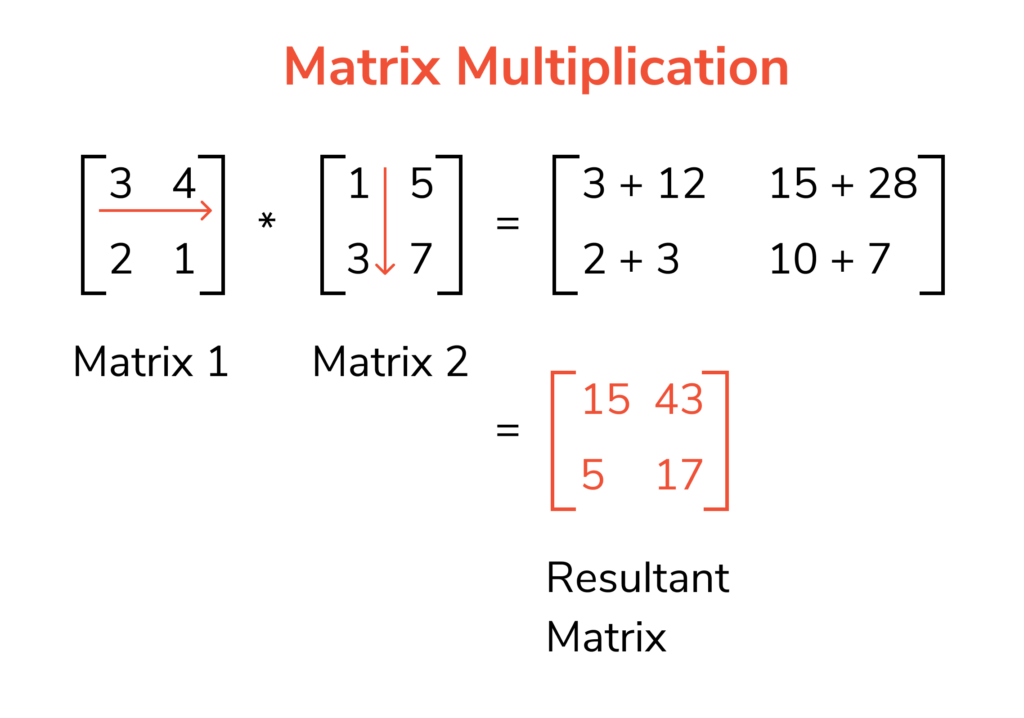The multiplication of two matrices is the process of multiplication. The multiplication operation on two matrices is possible only when they have the same order like 2 x 2 or 3 x 3. There are some properties for two matrix multiplication. We have given all the properties and problems along with some tips and tricks. Read the entire article and learn how to multiply two matrices. To learn the multiplication of matrices along with the multiplication of two matrices, read the 10th Grade Math articles on our website.
Also, Read:
What is meant by Multiplication of Two Matrices?
Multiplication of Two Matrices is a type of binary operation. So, if A and B are the two matrices, then the product of the two matrices A and B are denoted by X = AB.
If the dimensions are compatible then only you can multiply two matrices, which means the number of columns in the first matrix is the same as the number of rows in the second matrix. To multiply two matrices, order of the matrices need to be same. If A=[aij] is an m×n matrix and B=[[bij]] is an n×p matrix, the product AB is an m×p matrix. So, it will be AB=[cij], where cij = ai1 bj 1+ ai2 bj2…
2×2 Matrix Multiplication Formula
The process of any matrix order is the same. We can multiply the elements of each row of the first matrix by the elements of each column in the second matrix (that is element by element) as shown in the image. Finally, we add the products then the result of the product of two 2×2 matrices is again a 2×2 matrix.
 How to Multiply Two Matrices? | What is the Rule to Multiply Two Matrices?
How to Multiply Two Matrices? | What is the Rule to Multiply Two Matrices?
The following process will help you to know how to multiply two matrices. The multiplication process of matrices is a little bit difficult compared to the addition process.
- Initially, check that the number of columns in the 1st matrix is equal to the number of rows in the 2nd matrix (compatibility of matrices) or not.
- If the matrices have the same order, check out the same position elements.
- Next, multiply the elements of the ith row of the first matrix by the elements of the jth column in the second matrix and then add the products. This would be the element that is in the ith row and the jth column of the resultant matrix.
- Finally, place the added products in their respective positions.
Properties of Multiplication of Two Matrices
In the above-defined formula and procedure of multiplication of two matrices, we can write the following rules and properties for two matrices multiplication.
- If the product of two matrices A and B is defined as the number of columns of A is equal to the number of rows of B.
- If AB is defined, then need not be defined as BA.
- If A and B both are the square matrices of the same order, then both AB and BA are defined.
- If AB and BA are both defined, it is not necessary that AB = BA.
- If the product of two matrices is zero matrices, then it is not necessary because one of the matrices is a zero matrix.
Read Similar:
Multiplication of Matrix 2*2 Examples
Problem 1: The matrix is,
\( A = \left[
\begin{matrix}
1 & 0\cr
2 & 4\cr
\end{matrix}
\right]
\) and \( B = \left[
\begin{matrix}
6 & 8\cr
4 & 3\cr
\end{matrix}
\right]
\). What is the final product value of two matrices?
Solution:
As given in the question,
The matrix A is \( A = \left[
\begin{matrix}
1 & 0\cr
2 & 4\cr
\end{matrix}
\right]
\) and \( B = \left[
\begin{matrix}
6 & 8\cr
4 & 3\cr
\end{matrix}
\right]
\)
Now, we will find the final product value of two matrices.
After, multiplication of two matrix is \( \left[
\begin{matrix}
(1*6) + (0*4) & (1*8) + (0*3) \cr
(2*6) + (4*4) & (2*8) + (4*3) \cr
\end{matrix}\right] \)
\( \left[
\begin{matrix}
6+0 & 8+0\cr
12+16 & 16+12\cr
\end{matrix}
\right] \) = \( \left[
\begin{matrix}
6 & 8\cr
28 & 28\cr
\end{matrix}
\right] \)
Therefore, the final product value of the two matrix is \( \left[
\begin{matrix}
6 & 8\cr
28 & 28\cr
\end{matrix}
\right] \)
Problem 2: Show that the equation OX = O and XO = O holds if the matrix is,
\( X = \left[
\begin{matrix}
1 & 2\cr
3 & 4\cr
\end{matrix}
\right]
\) and \( O = \left[
\begin{matrix}
0 & 0\cr
0 & 0\cr
\end{matrix}
\right]
\)?
Solution:
As given in the question,
The matrix X is \( X = \left[
\begin{matrix}
1 & 2\cr
3 & 4\cr
\end{matrix}
\right]
\) and \( O = \left[
\begin{matrix}
0 & 0\cr
0 & 0\cr
\end{matrix}
\right]
\)
Now, we will equate the OX =O and XO=O
First, look at the equation OX =O
Calculating OX is,
\( \left[
\begin{matrix}
1 & 2\cr
3 & 4\cr
\end{matrix}
\right]
\). \( \left[
\begin{matrix}
0 & 0\cr
0 & 0\cr
\end{matrix}
\right]
\)
= \( \left[
\begin{matrix}
0(1)+0(3) & 0(2)+0(4)\cr
0(1)+0(3) & 0(2)+0(4)\cr
\end{matrix}
\right] \) = \( \left[
\begin{matrix}
0 & 0\cr
0 & 0\cr
\end{matrix}
\right] \) = O
Now, equate XO=O, that is
\( \left[
\begin{matrix}
1 & 2\cr
3 & 4\cr
\end{matrix}
\right]
\). \( \left[
\begin{matrix}
0 & 0\cr
0 & 0\cr
\end{matrix}
\right]
\) = = \( \left[
\begin{matrix}
0(1)+0(3) & 0(2)+0(4)\cr
0(1)+0(3) & 0(2)+0(4)\cr
\end{matrix}
\right] \) = \( \left[
\begin{matrix}
0 & 0\cr
0 & 0\cr
\end{matrix}
\right] \) = O
Hence, XO is equate to O and OX is equate to O.
Problem 3: Let \( A =\left[
\begin{matrix}
2 & 5\cr
-1 & 3\cr
\end{matrix}
\right]
\) and \( B= \left[
\begin{matrix}
2 & 5\cr
-1 & 3\cr
\end{matrix}
\right]
\). Find the values of AB and BA. Is AB = BA?
Solution:
Given that, the A and B matrices.
Here, A is the order of 2 × 2 and B is the order of 2 × 2.
So, the number of columns in A is equal to the number of rows in B. Hence, AB can be found. Also, the number of columns in B is equal to the number of rows in A. Hence, BA can also be found.
Now, find the value of AB,
AB = \( \left[
\begin{matrix}
2 & 5\cr
-1 & 3\cr
\end{matrix}
\right]
\) \( \left[
\begin{matrix}
2 & 5\cr
-1 & 3\cr
\end{matrix}
\right]
\) = \( \left[
\begin{matrix}
2×1 +5×4 & 2×1+5(-2)\cr
-1x 1 + 3×4& (-1)x1+3x(-2)\cr
\end{matrix}
\right]
\) = \( \left[
\begin{matrix}
22 & -8\cr
11 & -7\cr
\end{matrix}
\right]
\)
Next, find the value of the BA.
\( BA= \left[
\begin{matrix}
2 & 5\cr
-1 & 3\cr
\end{matrix}
\right]
\) \( \left[
\begin{matrix}
2 & 5\cr
-1 & 3\cr
\end{matrix}
\right]
\) = \( \left[
\begin{matrix}
1×2 + 1x(-1)& 1×5 + 1×3\cr
4×2+(-2) x(-1) & 4×5 + (-2)x3\cr
\end{matrix}
\right]
\) = \( \left[
\begin{matrix}
11 & 8\cr
0 & 14\cr
\end{matrix}
\right]
\).
Clearly, \( \left[
\begin{matrix}
21 & -8\cr
11 & -7\cr
\end{matrix}
\right]
\) ≠ \( \left[
\begin{matrix}
11& 8\cr
0 & 14\cr
\end{matrix}
\right]
\)
Therefore, the value of AB and BA is not equal. Hence it is AB ≠ BA.
Problem 4: Let \( X =\left[
\begin{matrix}
11 & 4\cr
-5 & 2\cr
\end{matrix}
\right]
\) and \( I= \left[
\begin{matrix}
1 & 0\cr
0 & 1\cr
\end{matrix}
\right]
\). Prove that XI = IX = X?
Solution:
Given that, the X and I matrices values.
The, X is the order of 2 × 2 and I is the order of 2 × 2.
So, the number of columns in X is equal to the number of rows in I. Hence, XI can be found. Also, the number of columns in I is equal to the number of rows in X. So, IX can also be found.
Now, find the value of XI,
XI = \( \left[
\begin{matrix}
11 & 4\cr
-5 & 2\cr
\end{matrix}
\right]
\) \( \left[
\begin{matrix}
1 & 0\cr
0 & 1\cr
\end{matrix}
\right]
\) = \( \left[
\begin{matrix}
11 x 1 + 4 x 0 & 11 x 0+ 4 x 1\cr
-5 x 1 + 2 x 0 & -5 x 0+ 2 x 1\cr
\end{matrix}
\right]
\) = \( \left[
\begin{matrix}
11 & 4\cr
-5 & 2\cr
\end{matrix}
\right]
\) = X
Next, find the value of the IX.
\( IX= \left[
\begin{matrix}
1 & 0\cr
0 & 1\cr
\end{matrix}
\right]
\) \( \left[
\begin{matrix}
11 & 4\cr
-5 & 2\cr
\end{matrix}
\right]
\) = \( \left[
\begin{matrix}
1 x 11 + 0 x(-5) & 1 x 4+ 0 x 2\cr
0 x 11 + 1 x(-5) & 0 x 4 + 1 x 2\cr
\end{matrix}
\right]
\) = \( \left[
\begin{matrix}
11 & 2\cr
-5 & 4\cr
\end{matrix}
\right]
\) = X
Clearly, \( \left[
\begin{matrix}
11 & 4\cr
-5 & 2\cr
\end{matrix}
\right]
\) = \( \left[
\begin{matrix}
11& 4\cr
-5 & 2\cr
\end{matrix}
\right]
\)
Therefore, the value of XI and IX is equal. Hence its proved XI = IX = X.
FAQ’s on Multiplication of Two matrices
1. What does a matrix represent?
Matrices represent functions between spaces, called vector spaces, and not just any functions either, but linear functions. This is the fact why linear algebra focuses on matrices.
2. What is the rule for multiplying given two matrices?
To multiply one matrix with another matrix, first, we need to check if the number of columns of the first matrix is equal to the number of rows of the second matrix. Next, multiply each element of the column of the first matrix by each element of rows of the second matrix and add them all. Here, we need to do the dot product of columns and rows.
3. Is it possible to multiply a 2×3 and 2×2 matrix?
Yes, the multiplication of the 2×3 and 2×2 matrix is certainly possible. So, the result also is a 2×3 matrix.
4. How do we find the multiplication of two matrices?
If A is an m×n matrix and B is a p×q matrix, then the multiplication of A and B is denoted by a dot matrix, such as C = AB. Thus, C will be an m×q matrix.
5. What is the Purpose of Matrix Multiplication?
Matrix multiplication is important for facilitating linear algebra computations and is used to represent linear maps. It is an important tool in many areas of mathematics, as well as in applied mathematics, statistics, physics, economics, and engineering.
6. What is the result of the multiplication of the (2×3) matrix and (3×3) matrix?
The result of the multiplication of the (2×3) matrix and (3×3) matrix will be the 2×3 matrix only.
Summary
The multiplication of two Matrices is provided in this article. So, without doing late go through the matrices concepts and prepare all the sub-concepts of the matrices. You can read all of our articles online and offline for free. If you want the best way of learning, you must go through our articles, worksheets, and practice tests, etc. Every article we provide here will give you the best practice and improves your knowledge.
